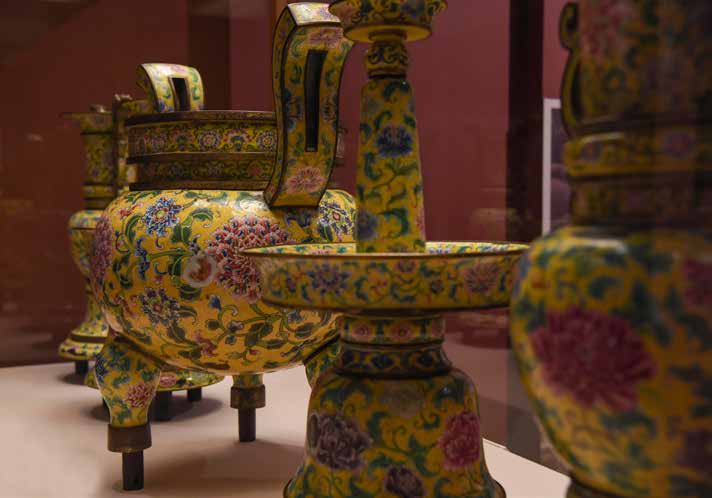Speaking for National Treasures

On January 22, 2020, with Chinese New Year, also known as Spring Festival, just around the corner, the National Museum of China was still bustling with visitors. Chinese people usually celebrate the most important traditional festival by hanging couplets and red lanterns and eating dumplings. But in recent years, visiting museums has become a popular celebration activity as Chinese people innovate their ways to spend the week-long Chinese New Year holiday.
Spring Festival in Museums
“This is an ancient bronze device,” Dai Meng, a tour guide at the National Museum of China,
explained to visitors. “When there is a little water in it, the device leans to one side; when it’s half full of water, it will stay still; when it’s full, it tips all the way over. The balancing act symbolizes the ‘middle way,’ neither right nor left, advocated by Confucianism.”
After graduating from the School of Archeology and Museology Peking University in 2012, Dai began working at the National Museum of China. Over the past eight years, she has worked as a tour guide at the museum during several Spring Festival holidays.
Dai has seen a rising wave of people visiting museums to celebrate Chinese New Year. “When I first started working during the Spring Festival holiday, it was lonely because there were so few visitors,” she recalled. “But in recent years, more and more people are coming to our museum to celebrate the occasion. Last year we enjoyed a big boom thanks in large part to an exhibition on China’s 40-year reform and opening up that attracted a lot of people, both local and out-of-town, to come and revisit their lives in memories.”
She attributes the rise to the development of various media, which have begun providing timely information about exhibitions for the public. And the improved living standards of Chinese people have driven them to seek nourishment for the mind and the soul. Museums are an ideal platform for such enrich- ment. “Museums are like big schools that facilitate absorption of histor- ical nutrition,” said Dai. “When visitors see relics and history from textbooks come alive, the feeling is wonderful.”
Dai noticed that many visitors come with questions, with some even asking complex academic questions. “After I introduce the cultural relics, they often seek in-depth discussion. Compared to years ago, today’s visitors are more interested in history and details. They come with more knowl- edge and eagerness to leave with profound understanding of these national treasures.”

After graduating from the School of Archeology and Museology at Peking University, Dai Meng has been working for the National Museum of China. Due to her work, Dai often spends her Chinese New Year holiday in the museum. by Ma Yue
Narrating History
During the week-long Chinese New Year holiday of 2019, the National Museum of China received nearly 400,000 visitors. As tour guides at the museum, Dai and her colleagues were so busy that they hardly had time to eat.
“During the Spring Festival holiday, visitors, old and young, swarmed into Beijing from other parts of China with their whole families,” stated Dai. “They were usually in great spirits, which inspired us a lot. We hope that our guide service would make them feel that the trip was worth taking and that they were taking something home. During my introduction, I sometimes see signs of ‘lights going on’ in their minds as they realize how history has such close connections to life today. This is an important function of museums—help visitors pinpoint connections between history and modern times to build a cultural identity and inspire greater interest in history.”
The treasures Dai covers span thousands of years. The long-term exhibition “Ancient China” traverses thousands of years. Dai and her colleagues spent several months preparing explanation text for the exhibition. Temporary exhibitions afford a much shorter time to prepare. “For each exhibition, we get a general frame for our explanation text including some selected relics,” said Dai. “And then we use our specialties and academic knowledge to enrich the materials. While preserving academic accuracy, we endeavor to use colloquial wording to introduce the relics to visitors.”
Thanks to her English proficiency, Dai often serves as a tour guide for foreign guests visiting the museum, including heads of state and United Nations officials. Dai has additional experience with cultural differences.
“Most foreigners are not very familiar with Chinese dynasties,” noted Dai. “So when we mention them, we often just specify the time period. For example, when we mention China’s Shang Dynasty (1600-1046 B.C.), we just say 3,000 years ago. Sometimes we put Chinese history in a global context. When we mention the Qin (221-206 B.C.) and Han (202B.C.-220 A.D.) dynasties, we link it to Roman times in the West. And when we talk about Zheng He’s voyages, we compare him to Columbus and Magellan so foreign visitors can better under- stand the time and significance of some milestone events in Chinese history.”
Dai considers herself somewhat of an introvert, but her work over the years has helped her break out of her shell. “National treasures are silent, so they need someone to speak for them,” she said.